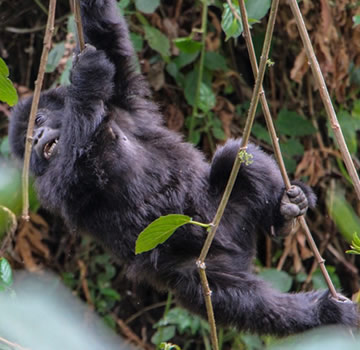As the population of mountain gorillas in Africa keeps growing every year, its necessary to acknowledge the role of gorilla tourism towards the protection and well being of mountain gorillas in the jungle.  Today the number of mountain gorillas is at 1008 from the most recent Virunga massif gorilla census collected from all the 4 places where gorillas gorillas live including Bwindi Impenetrable National Park and Mgahinga National Park in southwestern Uganda, Volcanoes National Park in northwestern Rwanda and the Virunga National Park in eastern Democratic Republic of Congo. Today, thousands of visitors come to East Africa to see the last remaining population of mountain gorillas in the world. Gorilla tourism is not only source of foreign exchange to respective gorilla destination but also major contributors to survival of mountain gorillas.
Today the number of mountain gorillas is at 1008 from the most recent Virunga massif gorilla census collected from all the 4 places where gorillas gorillas live including Bwindi Impenetrable National Park and Mgahinga National Park in southwestern Uganda, Volcanoes National Park in northwestern Rwanda and the Virunga National Park in eastern Democratic Republic of Congo. Today, thousands of visitors come to East Africa to see the last remaining population of mountain gorillas in the world. Gorilla tourism is not only source of foreign exchange to respective gorilla destination but also major contributors to survival of mountain gorillas.
Mountain gorilla tourism plays a key role in saving the lives of gorillas the fact that gorilla trekking has become one of the most sought after primate adventure in Africa. Gorilla trekking features as a major safari highlight in most of the visitors’ travel plans and so more efforts have been put to save these creatures in the wild.
To view mountain gorillas, visitors need gorilla trekking permit of which, each gorilla destination has its set price. In Uganda, gorilla trekking permits cost $600 per person-for foreign non-residents, $500 for foreign residents and Ug.Shs 250000 for East African Community residents. To obtain gorilla permit in Uganda, you need to get in touch with a reliable ground tour operator or reservation at Uganda Wildlife Authority (UWA). In Rwanda, gorilla permits cost $1500 per person and cuts across all visitors. You can secure your gorilla permit through a ground tour operator in Rwanda or reservation at Rwanda Development Board (RDB). In the DR Congo, gorilla permits can be secured at $450 per person-and this applies to mountain gorilla trekking in the Virunga National Park and eastern lowland gorilla adventures in Kahuzi Biega National Park.
Part of the fees or revenue collected from gorilla permits is used to fund most of the conservation activities-including patrols, paying park rangers, officials, support community related projects and others which in long run help protect and conserve not only mountain gorillas but also other wildlife species and their habitat.
There are many local community development initiatives that have been put in place. Respective gorilla destinations offer particular portion of revenue collected back to the community to support many local projects including bee-keeping, goat rearing, craft making and many others. This in long run is aimed at making local resident embrace significance of gorilla tourism and mountain gorilla conservation.
Besides, tourists do pay visits to local communities’ adjacent respective gorilla national parks which contribute directly to the development of their projects.
Lifestyle of mountain Gorillas
Mountain gorillas thrive in families just like humans with mature silverback gorilla being the leader. A mature silverback weighs up to 200 pounds which makes these creatures the largest apes in the world. Mountain gorillas largely vegetarians with their diet mainly focused on leaves, bamboo shoots, fruits and at times insects.
Mountain gorillas share 98 percent of their DNA with humans thus making them our closest relatives in the wild. Because of this, they are also prone to human infectious diseases a reason they need to be well-protected to avoid them from getting extinct. Other factors that hinder the lives of mountain gorillas include poaching, civil war and habitat loss among others.
Mountain gorilla conservation remains a major challenge to conservationist yet these creatures have the slowest reproductive rate. However, more efforts have been put to safeguard these creatures from getting extinct and currently, about 1004 mountain gorillas still exist on earth and distributed only in Bwindi Impenetrable National Park, Mgahinga National Park, Virunga National Park and Volcanoes National Park.

Leave A Comment